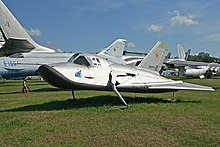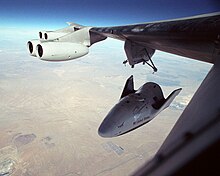Lifting body




A lifting body (also known as a supporting fuselage ) is an aircraft design in which the lift is not generated, or not solely, by the wings , but rather by a specially shaped fuselage . A construction of this type is suitable because of its greater stability compared to winged concepts and thus a simpler and more cost-effective construction, for example for space gliders . The term support hull is also used in hybrid airships , the hull of which was designed to generate dynamic lift.
development
The glider research arose from the idea of a spaceship that lands like a normal airplane after re-entering the earth's atmosphere . Wings should have been built to withstand the stresses and temperatures of extreme supersonic flight . One possible answer was to omit the wings altogether and design the fuselage to create lift. The space shuttle incorporates some of the lifting body principles, although it is primarily based on the concept of the delta wing .
The development wingless lifting body began with Dale Reed from the Dryden Flight Research Center of NASA . Early models like the M2-F1 were made of wood. In 1963, NASA began experimenting with rocket-propelled models dropped by a B-52 bomber as part of the Dyna Soar program . Another similar concept was the HL-10 , which was developed at NASA's Langley Research Center . The X-24 was based on the M2 concept developed by Dr. A. Eggers from the NASA Ames Research Center . The M-2 competed with the design of the space shuttle .
A major problem with these designs was the stall (Engl. Air flow separation ): Downstream was very turbulent airflow, resulting in a loss of control and buoyancy. In the HL-10 attempts were made to solve part of this problem by allowing the outer starboard - and starboard - fins of the tail inclined outwardly and enlarged the middle fin.
On the Soviet side, lifting body developments began in 1965, leading to the Mikoyan-Gurevich MiG-105 and Bor-4 , which were later abandoned in favor of the Buran program. In 2000, Kliper in the Russian Federation followed up on this development, but work was discontinued in 2007 for the time being.
Much of the population never knew about these glider models until they saw the 1970s television series The Six Million Dollar Man . It showed an M2-F2 flown by Bruce Peterson as it crashes and drags over the runway. The pilot survived and the aircraft was rebuilt as the M2-F3 .
The HL-20 Personnel Launch System was a NASA spacecraft concept in the late 1980s / early 1990s. It represented a passenger transporter in the form of a mini space shuttle for flights to the space station. Extensive studies on special test models were carried out, but no airworthy prototypes were built. Later, on the basis of this work, SpaceDev and subsequently the Sierra Nevada Corporation developed the Dream Chaser .
NASA's last lifting body project to date was the X-38 / CRV , a joint development with ESA , DLR and other European companies. The C rew R eturn V ehicle should serve as a rescue spaceship for the International Space Station (ISS) and, in an emergency, be able to accommodate the entire crew of the space station. The development of the CRV was stopped in 2001 for lack of money.
The concept for a lifting body airplane by the Swiss Konrad Schafroth, the Smartfish, is not based on the principle of bird flight, but takes the tuna as a model.
See also
- Martin-Marietta X-23
- Lockheed X-33 "Venture Star"
- Boeing X-43A
- Boeing X-48
Web links
- Data sheet "Lifting Bodies" from NASA ( Memento from June 9, 2010 in the Internet Archive ) (English)
- History of the Dryden Flight Research Center (English)
- History NASA, Wingless Flight: The Lifting Body Story (English)
- NASA Photo Collections from Dryden Flight Research Center (English)
- HL-10 ( Memento from July 16, 2012 in the Internet Archive )
- M2-F1 ( Memento from July 16, 2012 in the Internet Archive )
- M2-F2 ( Memento from July 16, 2012 in the Internet Archive )
- M2-F3
- X-24A and X24B ( Memento from March 24, 2013 in the Internet Archive )
Individual evidence
- ↑ Andreas Becker: Design and flight dynamics assessment of hybrid aircraft. (PDF; 11.3 MB) Dissertation TU Berlin. May 30, 2012, accessed April 27, 2020 .
